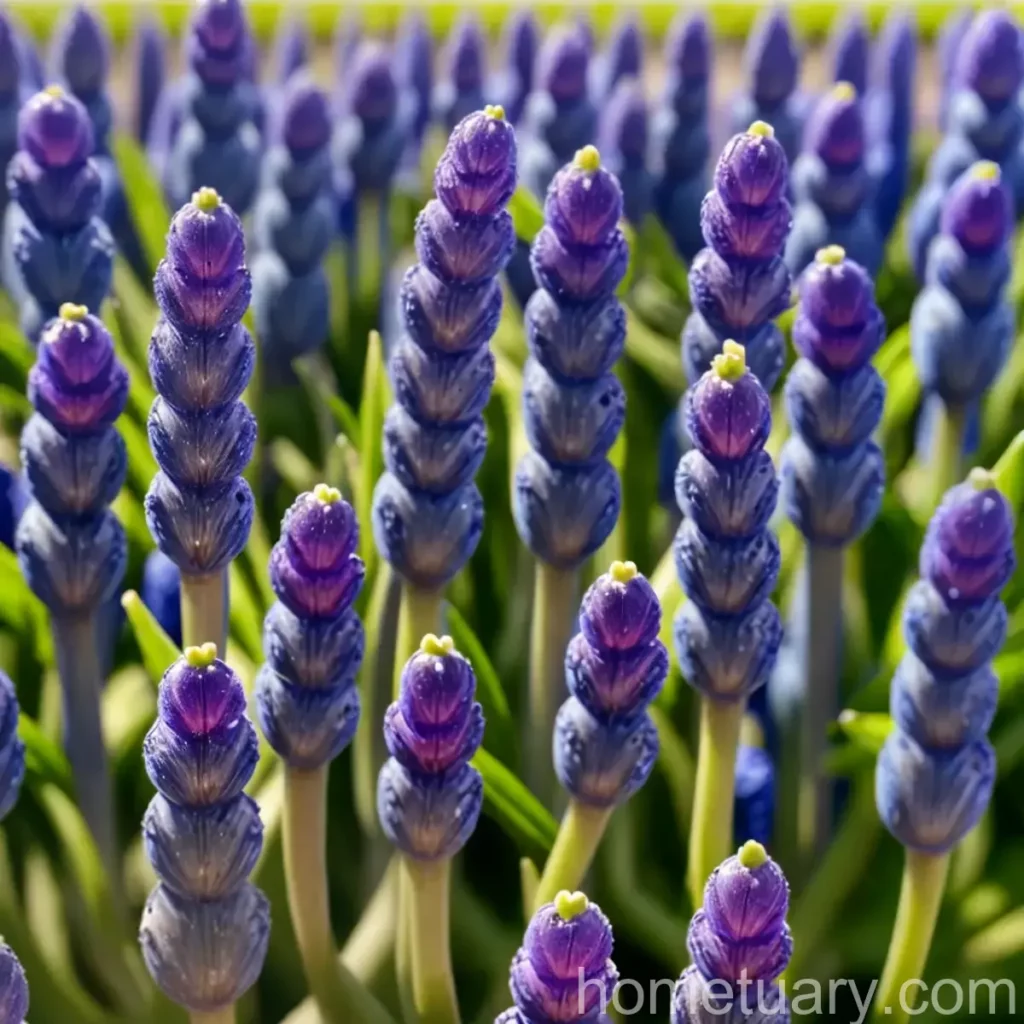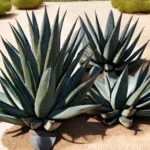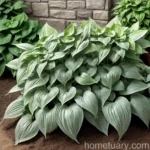Plant Scientist’s Guide to Grape Hyacinth (Muscari latifolium)
Grape hyacinth (Muscari latifolium) is a charming plant known for its clusters of tiny, bell-shaped flowers that resemble miniature grapes. As a plant scientist with a passion for horticulture, I am excited to delve into the world of this delightful spring-blooming bulb and provide a comprehensive guide on its cultivation, care, and uses.
What is Grape Hyacinth (Muscari latifolium)?
Grape hyacinth, scientifically known as Muscari latifolium, is a perennial bulbous plant belonging to the Asparagaceae family. It is native to the Mediterranean region and is widely cultivated for its ornamental value. The plant is characterized by its dense, conical racemes of small, urn-shaped flowers that bloom in shades of blue and purple, resembling clusters of tiny grapes, hence the common name “grape hyacinth.”
Grape hyacinth is a popular choice for garden borders, rock gardens, and naturalistic plantings, adding vibrant color and a touch of whimsy to the landscape. Its low maintenance requirements and adaptability to various growing conditions make it a favorite among gardeners and landscape enthusiasts.
Key Takeaways – Grape Hyacinth (Muscari latifolium)
Before delving into the specific aspects of grape hyacinth cultivation and care, let’s highlight some key takeaways that will be covered in this comprehensive guide:
- Scientific Name: Muscari latifolium
- Plant Type: Perennial bulbous plant
- Flower Characteristics: Bell-shaped flowers in shades of blue and purple
- Uses: Ornamental, landscaping
- Preferred Growing Conditions: Well-draining soil, adequate sunlight
- Maintenance: Low maintenance, suitable for naturalistic plantings
- Propagation: By offsets or seeds
- Disease and Pest Management: Relatively resistant, but may be susceptible to certain pests and diseases
- Container Gardening: Suitable for container cultivation
- Popularity: Widely cultivated for ornamental purposes
- Fun Facts: Fascinating tidbits about grape hyacinth’s characteristics and uses
Now, let’s explore each of these aspects in detail to gain a comprehensive understanding of grape hyacinth and how to cultivate and care for it effectively.
Culture
Cultivating grape hyacinth involves understanding its preferred growing conditions and cultural requirements. From soil preferences to flowering season, a holistic understanding of the plant’s culture enhances its successful growth and development.
Uses
Grape hyacinth’s ornamental value and landscaping potential make it a versatile plant with various uses in garden and landscape design. Understanding its uses can aid in integrating it effectively into different garden settings and achieving visually appealing results.
Water
Proper watering is essential for the healthy growth and development of grape hyacinth. Understanding its water requirements and best practices for watering can help maintain optimal moisture levels for the plant.
Sunlight
As with many plants, sunlight plays a crucial role in grape hyacinth’s growth and blooming. Understanding its sunlight requirements is essential for providing the ideal growing conditions for the plant.
Fertilizer
Appropriate fertilization can enhance grape hyacinth’s growth and flowering. Understanding the best fertilization practices for the plant is essential for promoting its overall health and vigor.
Soil
The type of soil in which grape hyacinth is grown can significantly influence its growth and performance. Understanding the plant’s soil preferences is crucial for creating an optimal growing environment.
Pruning
Proper pruning practices can help maintain the health and appearance of grape hyacinth. Understanding when and how to prune the plant is essential for ensuring its long-term well-being.
Propagation
Grape hyacinth can be propagated through various methods, such as offsets and seeds. Understanding the plant’s propagation techniques can empower gardeners to expand their grape hyacinth population effectively.
Container Gardening
The suitability of grape hyacinth for container cultivation opens up opportunities for incorporating it into diverse garden settings, including patios, balconies, and small urban spaces. Understanding its compatibility with containers and best practices for container gardening is essential for successful cultivation.
Popularity
Grape hyacinth’s widespread cultivation and popularity among gardeners and landscape enthusiasts underscore its appeal as a charming and low-maintenance plant. Exploring the reasons behind its popularity can provide insights into its enduring allure.
Common Diseases
While grape hyacinth is relatively resistant to diseases, certain issues may arise in specific growing conditions. Understanding common diseases and their management is crucial for proactive plant care.
Disease Diagnosis
The ability to identify and diagnose diseases affecting grape hyacinth is essential for implementing timely and effective treatment measures. Understanding the visual cues and symptoms of common diseases is vital for maintaining plant health.
Common Pests
Although grape hyacinth is generally pest-resistant, certain insects may pose a threat to its well-being. Familiarizing oneself with common pests and their management can help safeguard the plant from potential infestations.
Botanist’s Tips
Insights from a botanist’s perspective can provide valuable guidance on maximizing the growth and ornamental appeal of grape hyacinth. Incorporating expert tips into plant care practices can elevate the overall cultivation experience.
Fun Facts
Uncovering fascinating and lesser-known facts about grape hyacinth adds an element of discovery and appreciation to the plant’s unique characteristics and cultural significance. Exploring fun facts can deepen one’s understanding and admiration for this delightful species.
Now that we’ve outlined the key sections that will be covered in this comprehensive guide, let’s dive into the specifics of each aspect, delving deep into the world of grape hyacinth (Muscari latifolium) and providing valuable insights for cultivating, caring for, and appreciating this charming plant.
Muscari latifolium Planting Guide
Muscari latifolium, commonly known as grape hyacinth, is a delightful spring-blooming bulb that adds vibrant color and a touch of whimsy to the garden landscape. Known for its clusters of bell-shaped flowers that resemble miniature grapes, this perennial plant is a popular choice for garden borders, rock gardens, and naturalistic plantings.
When it comes to planting grape hyacinth, careful consideration of its preferred growing conditions is essential for ensuring its successful establishment and long-term vitality. Let’s explore a comprehensive planting guide for Muscari latifolium, covering aspects such as planting depth, soil preferences, and seasonal considerations.
Planting Depth
Understanding the appropriate planting depth for grape hyacinth bulbs is crucial for facilitating strong root development and robust growth. Typically, Muscari latifolium bulbs should be planted at a depth of 3 to 4 inches (7.5 to 10 cm) in well-draining soil to ensure optimal conditions for their emergence and flowering.
Soil Preferences
Grape hyacinth thrives in well-draining soil with a slightly acidic to neutral pH. The soil should be rich in organic matter, providing a fertile growing medium for the bulbs. Loamy or sandy loam soils are well-suited for grape hyacinth cultivation, offering the ideal balance of moisture retention and drainage.
Seasonal Considerations
The ideal time for planting Muscari latifolium bulbs is in the fall, several weeks before the first frost. This allows the bulbs to establish strong root systems during the cool season, setting the stage for vigorous growth and vibrant flowering in the spring. Planting in the fall also aligns with the plant’s natural growth cycle, ensuring it receives adequate chilling hours for optimal bloom development.
Growing Grape Hyacinth Muscari latifolium
Cultivating grape hyacinth (Muscari latifolium) offers an opportunity to adorn garden spaces with clusters of charming, grape-like flowers that imbue the landscape with vivid hues of blue and purple. Understanding the best practices for growing grape hyacinth is essential for fostering its health, vigor, and ornamental appeal. Whether you’re a novice gardener or an experienced horticulturist, mastering the art of growing grape hyacinth can enhance your gardening repertoire and elevate the visual allure of your outdoor spaces.
Suitable Climate
Grape hyacinth thrives in temperate climates and adapts well to regions with distinct seasonal variations. It favors cool to moderate temperatures during its growing season, making it an ideal choice for spring-blooming displays in garden beds, borders, and naturalistic plantings.
Watering Needs
Consistent moisture is essential for the initial establishment and subsequent growth of grape hyacinth. While the plant prefers well-draining soil, it benefits from regular watering, especially during its active growth and flowering stages. However, it’s important to avoid waterlogged conditions, as excessive moisture can lead to bulb rot and other issues.
Sunlight Requirements
Grape hyacinth flourishes in full sun to partial shade, making it adaptable to various light conditions. When provided with ample sunlight, the plant’s vibrant flowers and lush foliage thrive, creating captivating displays in the garden landscape. However, it can also tolerate dappled shade, making it suitable for diverse garden settings.
Soil Preferences
Well-draining soil with a slightly acidic to neutral pH creates an optimal growing environment for grape hyacinth. Amending the soil with organic matter, such as compost or well-rotted manure, can enhance its fertility and structure, providing an ideal foundation for the plant’s root development and overall vitality.
Maintenance Practices
Grape hyacinth requires minimal maintenance once established, making it a low-fuss addition to garden landscapes. Regular removal of spent flowers and yellowing foliage promotes tidiness and redirects the plant’s energy towards bulb development. Additionally, mulching the soil around the plants helps conserve moisture and suppress weed growth, contributing to the overall health of the plantings.
Muscari latifolium Care Tips
Caring for Muscari latifolium, commonly known as grape hyacinth, involves providing it with the optimal growing conditions and addressing its specific needs throughout the growing season. From attentive watering to prudent fertilization, following essential care tips can ensure the plant’s health, vigor, and striking floral displays. Whether you’re a seasoned gardener or a newcomer to the world of horticulture, incorporating these care tips into your gardening routine can elevate the success and visual impact of your grape hyacinth plantings.
Watering Guidelines
Proper watering is a fundamental aspect of grape hyacinth care, particularly during its active growth and flowering periods. While the plant prefers well-draining soil, it benefits from regular watering to maintain adequate moisture levels. However, it’s essential to strike a balance and avoid overwatering, as excessively wet conditions can lead to bulb rot and other issues.
Fertilization Practices
Applying a balanced fertilizer, such as a granular 10-10-10 formulation or a specialized bulb fertilizer, can support the growth and blooming of grape hyacinth. Fertilizing the soil in early spring, just as the plant begins its active growth, provides essential nutrients for robust flowering and healthy foliage development. Avoid excessive fertilization, as it can lead to lush foliage at the expense of flower production.
Mulching Benefits
Mulching the soil around grape hyacinth plants offers multiple benefits, including moisture retention, weed suppression, and temperature regulation. Organic mulches, such as shredded bark or compost, create a protective layer that conserves soil moisture and moderates temperature fluctuations, contributing to the plant’s overall well-being.
Seasonal Care
Monitoring grape hyacinth’s seasonal care requirements is crucial for promoting its optimal growth and longevity. From planting in the fall to nurturing the plants through their active growth and flowering stages in the spring, attentive seasonal care practices ensure that grape hyacinth thrives and delivers captivating displays year after year.
Grape Hyacinth (Muscari latifolium) Varieties
The diverse array of grape hyacinth (Muscari latifolium) varieties offers a palette of colors and characteristics that enrich garden landscapes and floral displays. From traditional blue hues to rare and exotic selections, exploring grape hyacinth varieties provides an opportunity to create captivating compositions and elevate the visual appeal of outdoor spaces. Whether you’re planning a spring garden bed or seeking unique additions to your landscape design, the world of grape hyacinth varieties offers an abundance of choices to inspire your gardening endeavors.
Traditional Blue Varieties
Classic blue grape hyacinth varieties, such as Muscari armeniacum, embody the quintessential charm of these spring-blooming bulbs. Their vivid blue flowers and compact growth habit make them popular choices for border plantings, rock gardens, and naturalistic landscapes. The alluring contrast of blue grape hyacinths against green foliage creates timeless spring displays that captivate garden enthusiasts year after year.
White and Cream Selections
Delicate white and cream-colored grape hyacinth varieties, such as Muscari aucheri ‘White Magic,’ introduce a soft and ethereal charm to garden settings. Their graceful blooms and subtle coloration offer versatility in floral arrangements and complement a wide range of companion plants, contributing to the overall elegance of the landscape.
Pink and Purple Cultivars
Exotic pink and purple grape hyacinth cultivars, including Muscari latifolium ‘Pink Sunrise’ and Muscari latifolium ‘Purple Passion,’ infuse garden landscapes with vibrant tones and captivating floral displays. Their unique color palettes and enchanting presence render them coveted additions to spring gardens and floral ensembles, enriching the visual tapestry of outdoor spaces.
Multi-Colored Mixes
Mixed varieties and blends of grape hyacinth bulbs showcase an enchanting medley of colors, creating dynamic and eye-catching compositions in garden beds and borders. These assortments often feature a harmonious fusion of blues, purples, whites, and pinks, offering an effortless way to introduce diversity and visual interest to the garden landscape.
Rare and Exotic Specimens
Rare and exotic grape hyacinth selections, such as Muscari latifolium ‘Golden Harvest’ and Muscari mischtschenkoanum, embody the allure of unique and sought-after cultivars. Their distinct characteristics, from variegated foliage to intricate flower shapes, intrigue collectors and discerning gardeners eager to incorporate exceptional specimens into their botanical collections.
How to Propagate Muscari latifolium
Propagating Muscari latifolium, commonly known as grape hyacinth, offers an exciting opportunity to expand your garden’s floral displays and share the charm of these delightful spring-blooming bulbs with fellow gardening enthusiasts. Whether you’re seeking to propagate new plants for personal enjoyment or to enhance the beauty of community landscapes, understanding and implementing effective propagation techniques is key to achieving successful results. From offsets to seeds, grape hyacinth offers multiple avenues for propagation, each with its own unique considerations and requirements.
Offset Division
Propagating grape hyacinth through offset division involves separating the small bulblets, or offsets, that develop around the parent bulb. This method is particularly effective for increasing the plant’s population and establishing new plantings in garden beds or naturalistic settings. Here’s a step-by-step guide to propagating grape hyacinth through offset division:
- Timing: Offset division is best carried out in late summer to early fall, when the parent bulbs have completed their growth cycle, and the offsets are mature enough for separation.
- Lifting the Bulbs: Carefully dig up the grape hyacinth bulbs, ensuring minimal damage to the offsets and their connecting roots.
- Separation: Gently detach the offsets from the parent bulbs, taking care to preserve their root systems and ensuring that each offset is equipped with its own growing point and sufficient energy reserves.
- Planting: Replant the separated offsets at the desired location in well-draining soil, ensuring adequate spacing to accommodate their future growth and establishment.
Seed Propagation
Growing grape hyacinth from seeds offers a rewarding and educational propagation experience, allowing gardeners to witness the plant’s complete life cycle from germination to flowering. While seed propagation requires patience and attention to detail, the process yields new plants with genetic diversity and the potential to introduce unique traits and characteristics. Here’s a step-by-step guide to propagating grape hyacinth from seeds:
- Seed Collection: Harvest ripe grape hyacinth seeds from mature seedheads, ensuring that the seeds are fully developed and ready for sowing.
- Preparation: Clean the harvested seeds, removing any debris or remaining plant material to ensure their viability and prevent potential fungal or bacterial issues.
- Sowing: Plant the cleaned grape hyacinth seeds in seed-starting trays or small pots filled with a well-draining seed-starting mix. Gently press the seeds into the soil surface, ensuring good seed-to-soil contact for germination.
- Moisture and Light: Keep the soil consistently moist but not waterlogged, and provide the planted seeds with bright, indirect light to support germination and seedling development.
- Transplanting: Once the grape hyacinth seedlings have developed several sets of true leaves, carefully transplant them into individual containers or directly into the garden bed, providing ample space for their future growth and establishment.
Muscari latifolium Bulbs for Sale
Grape hyacinth bulbs (Muscari latifolium) are sought-after horticultural treasures that captivate garden enthusiasts with their charming clusters of bell-shaped flowers and low-maintenance cultivation requirements. Whether you’re a seasoned gardener seeking to expand your bulb collection or a newcomer eager to introduce these delightful spring bloomers to your garden, acquiring high-quality grape hyacinth bulbs is a pivotal first step in the journey of cultivating and admiring these captivating plants. From local nurseries to reputable online vendors, a diverse array of sources offers grape hyacinth bulbs for sale, providing gardeners with access to a wide selection of varieties and bulb sizes to suit their preferences and gardening aspirations.
Local Nurseries and Garden Centers
Local nurseries and garden centers serve as convenient and trusted sources for acquiring grape hyacinth bulbs, offering the advantage of browsing in person and selecting bulbs that meet your quality and size preferences. These establishments often carry a selection of grape hyacinth varieties, allowing you to explore different colors, sizes, and bloom shapes before making your purchase.
Online Bulb Retailers
Reputable online bulb retailers provide a convenient and accessible avenue for purchasing grape hyacinth bulbs, offering a diverse range of varieties and sizes to suit various gardening needs. From traditional blue selections to rare and exotic cultivars, online retailers often feature detailed descriptions and images, enabling gardeners to make informed choices and acquire bulbs that align with their botanical vision.
Mail-Order Catalogs
Mail-order catalogs from reputable horticultural companies present an enticing assortment of grape hyacinth bulbs for sale, allowing gardeners to peruse and select their desired varieties from the comfort of their homes. These catalogs often showcase an array of grape hyacinth selections, along with companion planting suggestions and cultivation tips to inspire and guide gardeners in their bulb acquisitions.
Garden Club Sales and Events
Participating in local garden club sales and events offers an opportunity to interact with fellow gardening enthusiasts and procure grape hyacinth bulbs from knowledgeable sources. These gatherings often feature selections of bulbs grown and curated by fellow gardeners, fostering a sense of community and camaraderie while providing access to unique and specialty varieties.
Botanical Garden Sales
Many botanical gardens host seasonal bulb sales and events, offering a diverse array of grape hyacinth bulbs for sale alongside other spring-blooming favorites. These sales provide an immersive and educational experience, allowing garden















